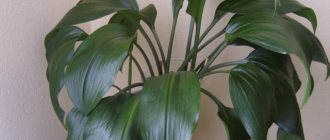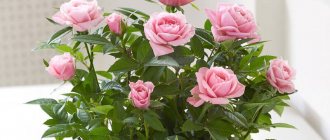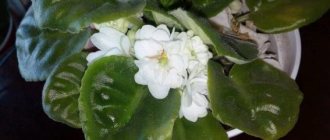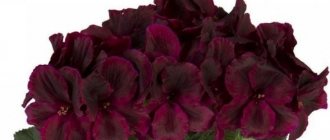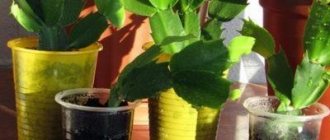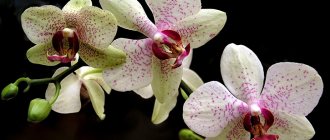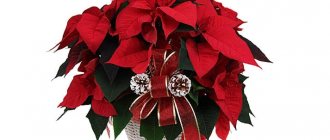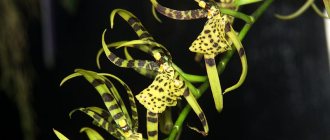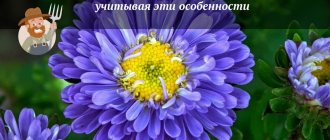Getting to know bougainvillea
Bougainvillea is a tropical plant that is named after the navigator Louis Antoine de Bougainville, who was the leader of a round-the-world expedition with the participation of the famous biologist Kimmerson, and he brought this plant to Europe.
Bougainvillea is native to South America, where it can grow as a vine, small tree or shrub with creeping stems that cling to the surface.
The shoots have spines with which they hold onto supports. Characterized by rapid growth. The average shoot length is about 5 meters. Under our climatic conditions, bougainvillea can only be grown at home or in heated greenhouses. The plant has rounded green leaves with sharp ends up to 8 cm long. The flowers are tubular, light yellow, small in size, and inconspicuous in appearance. The aesthetic appearance of the bush is achieved thanks to the bracts, which have a colorful appearance and a colorful paper texture. They can have different shapes and colors. The shape can be round, triangular or heart-shaped. The length varies from three to five centimeters. The color can be lilac, snow-white, lilac, orange, bright red or pink. Newly introduced bougainvillea varieties may have purple or bicolor bracts that change over time.
Despite the inconspicuous appearance and rapid fading of the flowers, the bracts decorate the plant for a long time. When growing bougainvillea indoors, flowering begins in May and continues until November.
Description
Bougainvillea is a genus that is part of the family Nociformaceae (Nyctaginaceae) and includes evergreen or deciduous climbing shrubs and trees, which are native to the tropical zone of South America.
The genus includes almost two dozen species, but mainly Brazilian ones are grown as indoor crops - Bougainvillea naked and wonderful. Thanks to the work of breeders, today, based on these species, many varieties and hybrids have been bred, which are successfully propagated by cuttings.
In the southern latitudes, where the temperature does not fall below 0°C all year round, vines are grown as spectacular tub crops and kept outdoors, widely used to decorate gardening areas and private areas - decorating arches, gazebos, fences and creating cozy patios.
Evergreen shrubs have branching shoots and slightly pointed oval-shaped leaf blades. The tubular flowers are small and rather unremarkable, but thanks to the 3 covering leaves that are wide and soft to the touch, the plants have an aesthetically attractive appearance. In nature, the color range of bracts is usually purple, but in bred varieties it varies from snow-white and soft pink to deep purple and other bright tones. In addition, the covering sheets can also be terry. When grown at home, plants bloom luxuriantly in spring and autumn, but bougainvillea requires proper care.
With the onset of autumn, the temperature of bougainvillea is lowered and watering is reduced. With the arrival of spring, temperature conditions begin to rise and watering increases.
Planting bougainvillea at home
Bushes should be planted in pots up to 5 liters. The larger the volume of the pot, the worse the flowering, since indoor bougainvillea begins to actively form leaves without forming buds. The soil for planting can be prepared independently or purchased at garden stores. To prepare the soil, mix coarse sand, leaf soil and turf in equal proportions, add a little expanded clay or broken brick. The soil must be nutritious and moisture-absorbing. The acidity is neutral or weak. A prerequisite for planting is to place a drainage layer at the bottom of the pot. The larger the volume of the container, the thicker the drainage layer should be.
Note to the florist
Why doesn't bougainvillea bloom?
There may be several reasons for this:
- Lack of fresh air;
- Not enough light;
- Excess moisture.
The solution to the problem is to eliminate the cause of the lack of buds: it is enough to place the plant in a bright place, regularly take it out onto the balcony or into the garden, it is also necessary to adjust the watering regime, and let the soil dry out a little. It is also important to know that at home, buds do not appear on old shoots that have already become woody.
Growing and caring for bougainvillea
Bougainvillea belongs to the Radiaceae family and has a total of 15 varieties, but only a few of them can be grown at home. Among them are bougainvillea glabra and bougainvillea remarkable. Since it is a tropical plant, it is grown in well-lit areas with plenty of open space. It is quite difficult to get beautiful bougainvillea at home, since it needs to be grown at a certain humidity and air temperature. In greenhouses, the tree is grown in large containers placed on the south side. Bougainvillea is best grown at home on glazed balconies, where the temperature can be maintained within 10 degrees in winter.
Indoors, choose a place where your indoor bougainvillea will receive sunbathing for at least five hours. This is one of the most necessary conditions for normal flowering and growth of the bush. If the pot with it is in a shaded place and receives insufficient light, its shoots grow thin and long, the leaves are pale, and flowering rarely occurs. It should also be taken into account that the tree is afraid of drafts and cold air currents. In summer, you can place pots with plants on an open balcony, protected from the wind.
Bougainvillea is fertilized once every two weeks, alternating mineral fertilizers with organic ones. During the period of active vegetative growth, which begins in May, the flower is fertilized with phosphorus-potassium fertilizers. In winter, the plant is not fertilized or sprayed.
Much attention should be paid to watering the flower. In summer, this is done once or twice a week, when the top layer of soil has dried to the thickness of half a phalanx of a finger. The pot must have a drainage layer, as the plant is sensitive to stagnation of water. The water that collects in the pan after moistening must be drained, as it provokes rotting of the roots and death of the plant.
In winter, indoor bougainvillea is watered once every two weeks. The lower the temperature in the room, the less often you water.
Types and varieties
Bougainvillea is common in South America; it is found everywhere in parks, squares and decorates residential buildings. Plants are used to decorate walls, columns, pavilions and gazebos, since caring for them is quite simple. The flowers of these vines are inconspicuous, small, but the leaves with a papery texture and various colors are very decorative. Common types of bougainvillea Wonderful, or beautiful, bougainvillea is often used in landscape design, as it grows quickly, forming “living walls”. The bracts gradually turn pale, creating smooth transitions and giving the bushes a special charm. Bougainvillea peruviana blooms very long and luxuriantly, but branches poorly. Bougainvillea Butte (a hybrid of naked and Peruvian) is the founder of many modern varieties. Smooth Bougainvillea - These vines have glossy leaves and colorful bracts and are often used to create hybrids. At home, two types are most often grown: smooth and wonderful bougainvillea.
Terry hybrids are very attractive: bouquets of bright bracts, most often purple, completely cover the foliage during flowering.
Several popular varieties of this plant: Apple Blossom - white and pink bracts; Australian Gold - double bracts, colored salmon-orange; Australian Pink – pink bracts, easy care, blooms profusely; Double Red – double, purple bracts; Glabra Variegata – variegated variety, lilac bracts; Mini Thai - light pink or orange bracts.
Replanting bougainvillea
Transplantation is done once every 5 years to rejuvenate old bushes and once every 2 years to activate growth in young bushes. This procedure is carried out in the spring before flowering begins. When transplanting, transfer the root system along with a lump of earth into a larger pot. Two fingers should be placed between the edge of the earthen ball and the wall of the new pot. The empty space is filled with fresh soil mixture.
Bougainvillea slowly gets used to its new location at home, so moving it from place to place is not recommended. In this case, it can throw off buds and leaves.
But if the growing conditions in the new mass are better, it grows new green mass and after some time begins to bloom profusely. The active growing season occurs in spring and autumn. During this period, the temperature in the room should be around 22-25 degrees. It is recommended to moisten the leaves from the sprayer with sifted soft water so that it does not fall on the bracts.
Diseases and pests
In general, the plant is quite resistant to diseases and pests. However, in some cases, aphids, mealybugs and spider mites may appear on bougainvillea.
To promptly detect insects on plants, it is necessary to regularly inspect the stems and leaves of bougainvillea. At the slightest sign of damage, control measures must be taken. As a rule, special chemicals are used to kill insects.
As a preventive measure, it is necessary to monitor the hygiene of the flower, regularly wipe off dust, and remove dry leaves and inflorescences.
Keeping bougainvillea in winter
In winter, bougainvillea requires special care. This is due to the fact that the duration of daylight hours decreases sharply and the plant begins to feel a lack of lighting. In winter, indoor bougainvillea needs to create rest. Move the bougainvillea pot to a well-lit, cool place with a temperature of about 5-10 degrees and stop watering. At temperatures above this, the plant will not go dormant, but will continue to grow and bloom. However, this will greatly deplete it and make it weak, which will negatively affect flowering in the spring. With the onset of warmth and increasing daylight hours, the temperature of the room is gradually increased, and watering is done more often.
How to propagate
From spring to late summer, bougainvilleas can be propagated by apical cuttings, as well as layering. The seed method is usually not used at home, since the seeds of most varieties are not viable.
The rooting substrate must be well permeable to air and moisture. It can be made from peat and sand (1:1). Mandatory conditions are high humidity and soil temperature - not lower than 25°C, so bottom heating must be provided. To do this, you can use special electric warm mats for seedlings or other available means.
From the bush, usually during pruning, a semi-lignified 10-centimeter cutting is cut off with a sharp and clean tool. First, it is kept for several hours in warm water, and then treated with a biostimulator of root formation. Afterwards, the cuttings are planted in a container with a warm substrate. You can cover the top with polyethylene or glass, but in this case you need to open the mini-greenhouse daily. Roots develop within 4-6 weeks.
If the bush has low-lying shoots, then you can carefully tilt one of the stems and fix it close to the soil. It is advisable to separate the baby plant from the mother plant in spring or autumn.
Propagation of bougainvillea at home
Bougainvillea can be propagated in two ways: cuttings or layering.
- Propagation by cuttings. If you want to carry out cuttings in the spring, cuttings taken from the tops of branches after cutting are suitable for this. They should be cut into ten-centimeter pieces. In summer, cuttings are cut separately. In such a way that the lower cut is as low as possible under the lower bud. The leaves are torn off to the middle. The cuttings are placed in a solution with a rooting agent for several hours. The pots are filled with finely chopped sphagnum moss, coal and sand. The cuttings are placed in this substrate up to the second internode at an angle of 45 degrees, covered with film or placed in a greenhouse, creating a temperature for rooting of 21-23 degrees. During the rooting process, high humidity, diffused light and average soil moisture should be maintained. The seedlings are periodically sprayed and ventilated.
- Reproduction by layering. This method is most often used in greenhouses on plants with large pots. Long stems are cut in a circle and pressed to the ground with wire or wooden brackets, covered with a layer of fertile soil on top and moistened. After some time, new stems emerge from the axillary buds, which develop an independent root system. After the shoot becomes strong, it is cut off from the mother plant with pruning shears and planted in a permanent place.
Features of growing bougainvillea at home - from planting to pruning
The beautiful bougainvillea is an evergreen shrub of the Niktaginov family, named after the French navigator Louis Antoine De Bougainville, who brought the plant from the hills of Rio de Janeiro to France.
Many people believe that bougainvillea grows and reproduces at home extremely difficult, and caring for it causes a lot of trouble, but this is not so. With a little effort and having studied all the intricacies of propagation, planting and care, you can admire the luxurious clusters even on the windowsills of residential apartments.
- Briefly about the beautiful bougainvillea
- Temperature and lighting requirements
- Watering and proper fertilization
- Rules and features of transplantation
- Reproduction at home
- Technique for forming a beautiful bush
Briefly about the beautiful bougainvillea
Bougainvillea includes approximately 15 species of beautiful flowering shrubs in its genus. Tree branches have thorns. Breeders have managed to develop varieties for home floriculture that have very few thorns, but it is not yet possible to completely get rid of them.
Bougainvillea flowers are not at all remarkable, small, vanilla-white, hidden in the depths of three bracts - they surprise with their beauty and create the illusion of bright large flower heads. In nature, bracts range from pink to purple, and the work of breeders has made it possible to grow bougainvillea with bracts of white, yellow, orange, brick and other colors.
Temperature and lighting requirements
Bougainvillea is accustomed to a subtropical climate, therefore, one of the most important conditions for growing at home is to ensure the required temperature conditions. During the period of active growth and flowering, the daily temperature is desirable within 25-30 degrees. Night - not lower than 20 degrees.
Important : temperatures above 42 degrees have a negative effect on the plant, causing it to wilt and drop leaves and flowers.
For the dormant period, it is desirable to ensure the ambient temperature is within 10-15 degrees, but a warm winter with a temperature of 15 to 20 degrees is also allowed.
Growing bougainvillea at home requires the maximum amount of light, so southern windows are suitable. She is not afraid of direct sunlight and can grow without shading. When placed on northern or western windows, the plant needs additional lighting; without it, the vine will not bloom.
Watering and proper fertilization
Bougainvillea is very demanding when it comes to watering. During the growing season and flowering, it should be watered abundantly with settled water at room temperature, avoiding moisture retention. With insufficient watering, if even a short-term drying out of the earthen clod occurs, the plant begins to shed leaves and flowers. In winter, watering is reduced, watering as the earthen clod dries out by half.
When growing bougainvillea at home, fertilizing is carried out in the spring and summer: starting in April and stopping in September. Use complex fertilizer or compounds for beautifully flowering indoor plants. The optimal content of nitrogen, potassium and phosphorus is 20-20-20. The frequency of feeding is once every 3 weeks.
Rules and features of transplantation
Young plants are transplanted annually at the beginning of spring into pots larger in diameter than the previous ones by 2-3 cm. After reaching the age of three, replanting is carried out every 2-3 years.
Choose a glazed ceramic pot with a mandatory drainage hole. It has been noticed that bougainvilleas feel worse in plastic pots and grow more slowly. At least 3 cm of drainage is poured onto the bottom.
The soil for planting should be slightly acidic or neutral. It should be remembered that in a slightly acidic environment (pH = 6.5) the content of phosphorus and other microelements is optimal for the plant, and with such a soil reaction, they are in an accessible form for the root system.
The composition of the soil should ensure good air exchange. When choosing a ready-made mixture, you should give preference to soil for flowering plants, adding 20% perlite or vermiculite. You can independently prepare the soil for planting bougainvillea by mixing turf and leaf soil, humus and sand in the ratio 2:2:1:1.
Reproduction at home
Most often, the vegetative method is used to propagate bougainvillea at home - with young green cuttings (from June to August) or semi-lignified cuttings (from March to May).
- Using a sharp knife, cut cuttings from the middle part of the shoot 10-15 cm long. The upper cut is horizontal, the lower cut is at an angle of 45 degrees.
- From the lower cut side, leaves are removed to 2/3 of the height.
- The cutting is placed in a root formation stimulator for the time specified by the manufacturer.
- The prepared cuttings are buried 5 cm in the soil for rooting. The soil for this is prepared as follows: mix leaf soil and perlite in a ratio of 2:1, then steam the mixture in the oven for 10 minutes or in the microwave for 5 minutes at maximum power and pour into plastic cups with perforated bottoms.
- After planting, the cuttings are watered with warm, settled water and covered with a cap from a plastic bottle or a plastic bag.
- The cuttings are regularly ventilated and the soil is moistened. It is necessary to ensure that the air temperature does not fall below 23 degrees .
- Lighting should be moderate, however, rooted cuttings should be protected from direct sunlight.
- The cover is removed gradually when the roots of the plant reach 2-3 cm, then the cuttings are transferred to a permanent place.
Important : when choosing a location for bougainvillea, you need to take into account that the plant does not like rearrangements; constant movements can cause a slowdown in development.
Technique for forming a beautiful bush
In order to speed up growth and flowering, the plant is pruned. Timely pruning of bougainvillea stimulates the growth of side shoots, thanks to which you can form a beautiful bush, and also helps to increase the strength of the plant.
Pruning, which is carried out after the end of flowering, stimulates the further formation of flower buds. In the fall, heavy pruning is carried out at the end of the growing season. In the spring, they form a bush by cutting off the shoots in the area of the fifth internode and removing protruding branches.
To give the bougainvillea bush the desired shape, a fence or trellis is placed in the flowerpot, on which the branches are secured with special soft plant clamps, pointing in the right directions.
Floriculture expert Nastasya Vorob told readers of the Women's Hobbies website about how to grow bougainvillea at home.
Pruning and shaping the crown of indoor bougainvillea
When growing bougainvillea at home, you should prune it every year. This will contribute to the preservation of the decorative appearance, the formation of the bush and greater formation of flower ovaries. The procedure is done in autumn or winter. The stems are cut to half, thus activating the growth of side shoots. Some gardeners prune indoor bougainvillea in the spring. This promotes the development of a dense bush and the removal of crooked, diseased, thin and unnecessary shoots. In summer, pruning is carried out after the flowering period. This stimulates the re-formation of flower ovaries. It is not recommended to prune three or four year old branches. Some varieties of bougainvillea can be formed into various shapes by tying shoots to special supports of different configurations: an arch, a ball or a heart. Pruning is an important step in bougainvillea care.
Bougainvillea varieties
There are 14 species of bougainvillea in nature, but gardeners cultivate only two of them:
- Bougainvillea is naked. This is a vine-like plant with glossy round leaves and thorns on the shoots. The bracts are white, bright red, purple or pink and have small yellow flowers that are located on them. The flowering period begins in April and lasts for a month. Under natural conditions, vine shoots can be up to 6 meters long, but in greenhouses and home cultivation their length does not exceed three meters.
- Bougainvillea is beautiful . A fast growing plant with velvety oval leaves. The flowers are collected in paniculate inflorescences of two or three, located on bright bracts of pink-green, pink-violet or red. The central stem can grow up to 15 m in length.
In addition to these two species, there are a huge number of different innovative varieties that differ in the color of their bracts. It can be bright orange, coral, crimson, pink, rich yellow, snow white, purple, ruby red and other colors.
Problems faced by flower growers
When growing bougainvillea, gardeners often encounter various problems: lack of growth, drying of shoots, shedding of inflorescences. Bougainvillea is a grateful plant. If you care for it correctly, replant it on time, and protect it from insects, then it will delight you with its beauty. If the appearance of the plant does not satisfy you, you need to look for the reason why the bougainvillea has changed. Don’t start the problem: the sooner measures are taken, the higher the chances of saving the plant.
Diseases and pests
Bougainvillea, like any other plant, can get sick and be attacked by pests. Fortunately, this doesn't happen often. But the owner of the tropical beauty needs to be on guard, because the speed of the reaction determines whether the “green pet” will be able to recover. Diseases are treated with proper care and feeding. Insecticides will help get rid of insects. The basic principles of treatment are described in the table.
Table - Diseases and pests: signs, treatment
| Pest, disease | Signs | Treatment |
| Aphid | - Bracts are deformed; - leaves curl; - new shoots die | — Removal of affected areas; — spraying with insecticides (“Decis”) |
| Spider mite | — Leaves turn yellow and fall off; - a cobweb is visible on the petioles | — “Swimming” in the shower; — exposure to cold (6-15°C); — treatment with drugs containing “Permethrin”; — spraying with insecticides (“Kinmiks”, “Admiral”) |
| Mealy mite | - Leaves turn yellow and wither; - white sticky fluff appears | — Wiping the leaves with a cotton pad soaked in a soap solution; - spraying with insecticides designed to combat mealy mites |
| Powdery mildew | — White coating on the leaves (if you don’t react immediately, they will turn brown) | — Removal of affected areas; - dusting with sulfur; – treatment with drugs (for example, “Bayleton”) |
| Root rot | - Blackening of shoots; - loss of leaves | — Removal of rotten parts of the root system; - dusting the sections with crushed activated carbon; — treatment with a root-forming preparation; - change of substrate |
| Chlorosis | — Leaves lighten and may turn yellow; - white spots appear on the sheet material | — Treatment with “Fitoferm”; — fertilizing |
To prevent diseases, you need to optimize plant care. Be sure to inspect the flower for parasites. If you heard the first alarm bell, take the necessary measures.
Insects usually enter the house along with new indoor plants. Remember the rule: the new “pet” must undergo a two-week quarantine, only after that it can be adjacent to the plants that are already in your home.
Improper care
Most often, bougainvillea begins to wither when the rules of care are violated. Insufficient or excessive watering, too dry air, drafts, unsuitable substrate, lack of light - all this does not have the best effect on the condition of the plant. And don’t forget that bougainvillea does not like changes: frequent replanting and rearranging of the flowerpot can cause it to dry out. The table presented below will be a hint for novice gardeners and help them understand what went wrong.
Table - Problems when growing bougainvillea and their causes
| Problem | Possible reasons |
| Yellow leaves | — Waterlogging of the soil |
| Leaves or bracts fall off | — Drafts; — lack of lighting; - redirection of escapes; - temperature change |
| Pale leaves and bracts | — Insufficient nutrients; - bad light |
| Brown spots on leaves | — Low temperature combined with high humidity |
| The flower dries, the leaves turn black | — The soil mixture is too dry |
| Bracts become deformed | — Air is too dry |
A plant that blooms all year round looks worse than one that has rested. A long flowering period weakens bougainvillea. Experienced flower growers recommend forcing the tropical guest to spend the winter by lowering the room temperature and shading the flower.
Do not rush to throw away the plant, even if it seems that it is completely dry. It’s easy to check if bougainvillea is dead: cut off a branch. The cut is “live” - there is a chance that the plant will recover. If the flower has dropped its leaves before wintering, just provide it with coolness, try not to over-water it. It seems that the bougainvillea has dried out in the summer - set up a “greenhouse”.
When to prune
Bougainvillea becomes disheveled and untidy if not trimmed. Haircuts can be done at any time of the year. In the fall, before leaving for winter rest, the branches are shortened by half. Thanks to this, the bush rejuvenates and the side shoots grow more actively. Pruning in spring is a healing procedure. Remove excess, weak, uneven branches, make those that are too long shorter. In summer, faded brushes are removed; this pruning stimulates new flowering.
It is not recommended to trim lignified branches of adults older than 3 years. With age, the number of dormant buds decreases. And by cutting off old shoots, you take a risk: young side branches may not appear.
Bougainvillea responds favorably to pruning. And its branches are very plastic. Therefore, without much effort they can be given an interesting shape. For example, plant plants with differently colored bracts in one pot and intertwine them. Place the vine on a support of some shape, grow a fluffy bush or standard. Those who are patient can experiment by forming bougainvillea into a bonsai.
Tools
To prune bougainvillea, prepare thick gardening gloves, garden shears, and a disinfectant such as bleach or rubbing alcohol.
Wipe down your garden shears with disinfectant to prevent disease from infecting your bougainvillea.
After pruning diseased shoots, disinfect pruning shears before trimming the branches to prevent infection.
Bougainvillea: care and maintenance in open ground
After wintering, the plants are transferred to outdoor mode, at an average daily temperature above +10 °C. Bougainvillea begins to grow actively, the lashes stretch up to 3 m in length. The main care and maintenance of bougainvillea in the open ground consists of timely watering and pruning.
Watering mode
Water bougainvillea in the garden in the mornings generously 2 times a week with settled water heated in the sun. In hot weather, spray the leaves daily.
With a lack of moisture, the plant sheds green leaves; with excess and stagnation, the foliage first turns yellow and then falls off.
Note! Spraying does not affect the bracts; they are left dry. During periods of prolonged rain and cold weather, the plant is protected with film
Optimum daytime temperature for flowering is from +21 to +25
During periods of prolonged rains and cold weather, the plant is protected with film. The optimal daytime temperature for flowering is from +21 to +25.
Top dressing
Fertilize young plants once a week, older ones - once every 2 weeks with a complex fertilizer containing nitrogen and phosphorus. What to feed an adult bougainvillea for flowering depends on what is on hand. It is best to fertilize it with a composition containing potassium, phosphorus and iron once every 2 months. Before each planting procedure, pre-water.


